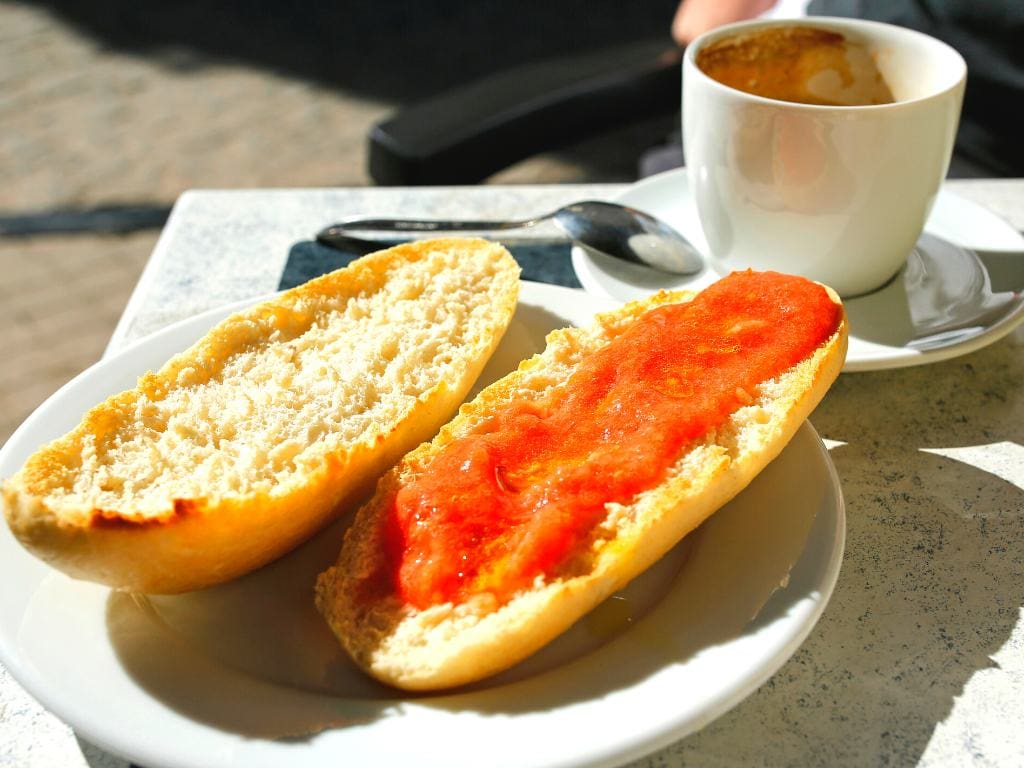What is Almuerzo in English? (Mid-morning Snack in Spain)
Disclaimer: Links on this page may be affiliate links. If you make a purchase after clicking a link, I may receive a small compensation to help power my site at no cost to you.
What is “almuerzo” in English? Learn all about Spain’s mid-morning snack and find some typical Spanish snacks, too!
Having lived and traveled extensively in Spain, I’m quite accustomed to Spanish mealtimes. And while the concept of eating dinner at 10 pm still baffles me, I absolutely love eating el almuerzo!
If you’re headed to Spain, you need to know what “almuerzo” is in English, too! That way, you can fully immerse yourself into Spanish culture.
In this post, we’ll go over what almuerzo is English. Plus, we’ll delve into all the details about the almuerzo: when and why Spanish people eat almuerzo, its Spanish meaning and customs, and how to pronounce almuerzo. We’ll also list the best Spanish almuerzo ideas to prepare you to eat like a local!
What is Almuerzo in English?

So, what is the meaning of almuerzo?
Almuerzo is Spain’s traditional morning snack or “second breakfast”. Loosely translating to “light morning meal,” the almuerzo is a light meal that’s usually eaten in the late morning—around 10-11 am.
No, it’s not lost on Spaniards that 11 am is nearing lunchtime in many countries. But, Spain has its own customs when it comes to mealtimes. In fact, the almuerzo is Spain’s second meal of five! It follows first breakfast (desyauno) and comes before lunch (comida), afternoon snack (merienda) and dinner (cena).
While many tourists are ready to eat a late breakfast, brunch, or lunch around 11 am, Spaniards are headed to cafeterías for the all-important morning snack, or almuerzo.
After all, they need to tide themselves over seeing as they don’t eat lunch until 2 or 3 pm! Plus, the first breakfast of the day (desayuno) is often very light like simply a glass of chocolate milk!
Almuerzo is also a social affair, with many Spaniards eating in groups (I always went out with my coworkers, for example).
Despite the complicated rules regarding Spanish mealtimes, the almuerzo is pretty simple. It’s a time for a morning break. In fact, don’t be surprised if you stop into a small business around almuerzo time to find it closed for 30 minutes.
Spanish almuerzo often consists of a sweet or savory snack, like a pastry or toast accompanied by a coffee. Students also have a little break where they typically eat a small sandwich from home. We’ll review the most popular Spanish morning snacks in the section, below.
What Does Almuerzo Mean in Spanish?

Almuerzo is one of those words in Spanish that doesn’t quite have an English translation. But, you’ll hear most travelers call el almuerzo Spain’s “second breakfast” or “mid-morning snack.”
The Real Academica Española’s (the institution in charge of the Spanish language) definition of almuerzo is “a meal that’s eaten in the morning”
It should also be noted that almuerzo refers to lunch in some Spanish-speaking countries.
There are several ways to use the terms “almuerzo” and “almorzar” in Spanish to describe having a mid-morning snack.
El almuerzo – Morning Snack (n)
The snack food or meal itself is referred to as the almuerzo.
- What is your favorite morning snack? (¿Cuál es tu almuerzo favorita?)
El almuerzo – Snack Time (n)
When you’re talking about meeting for the almuerzo (gathering, snack time), you can use the word almuerzo.
- The students are meeting up for snack time. (Los alumnos se reúnen para la almuerzo.)
Almorzar – To Have a Morning Snack (v)
You can use the verb for almorzar to describe having a snack in the morning or to say, “to snack in the morning.”
The Real Academica Española (RAE) defines almorzar roughly as “the action of eating the mid-morning snack.”
- We usually snack after the meeting. (Normalment almorzamos después de la reunión.)
How Do You Pronounce Almuerzo in English?
The pronunciation of almuerzo is ahl-mwer-soh.
For more help, watch this video on how to pronounce almuerzo (mid-morning snack) in Spanish. ⤵
The Origin of Almuerzo in Spain

While the exact origins of the morning snack in Spain are elusive, the etymology of the word suggests both Latin and Arabic roots.
The word almuerzo comes from the Latin word morsus (bite) or Vulgar Latin admordium. The verb form almorzar comes from the Latin verb admordēre (to bite into).
The prefix al- would have been added because of the influence of Arabic.
The first known use of the word was just in 1851!
5 Typical Spanish Almuerzo Ideas

The almuerzo is an integral part of daily life that many Spaniards and tourists enjoy. Although regional differences in the almuerzo should also be expected, here are some of the most typical Spanish morning snacks you can plan to eat during the almuerzo in Spain.
1. Coffee – Café
Coffee is a must in the morning while visiting Spain. Besides, it tastes good with both sweet and savory snacks.
2. Pastries – Pasteles
Spanish pastries (sweet or savory) are an excellent option for almuerzo along with coffee or tea. Choose from napolitanas (chocolate croissants), ensaimadas (traditional sweet pastry from Mallorca) or various regional specialties all across Spain.
3. Toast – Tostada
Spanish toast is one of the most well-known and affordable “second breakfast” foods in Spain. Toast is typically topped with jamón (cured ham), cheese, tomato, or olive oil. It pairs well with coffee and freshly-squeezed orange juice. Toast is also quick and easy if you want to grab the ingredients for a homemade almuerzo.
4. Spanish Omelet – Tortilla española
One of the best-known Spanish foods is Spain’s delicious omelet, tortilla. Spanish-style omelets are made of egg, onion, and potato and cooked in olive oil. Tortillas are popular all over Spain, where a thick slice makes a perfect almuerzo! If you’re looking for almuerzo recipes, tortillas are easy to make yourself, too!
5. Zumo – Juice
Freshly squeezed juice (particularly orange juice) is popular in Spain and offers a punch of energy in the morning. It’s healthy, too!
Useful Spanish Expressions Associates With Almuerzo
You may be surprised to hear that there are even more phrases related to the word “almuerzo” in Spanish:
✔ to snack in the morning — almorzar
✔ to eat lunch (more common in Latin America) — almorzar
✔ healthy morning snacks — almuerzos saludables
✔ cheap morning snacks — almuerzos baratos
✔ Do you want something to snack on (in the morning)? — ¿Quieres algo de almorzar?
✔ to go for Spanish second breakfast — ir de almuerzo
✔ business lunch — almuerzo de negocios
✔ working lunch — almuerzo de trabajo
✔ packed meal — almuerzo (de viaje)
✔ elevenses (UK) — almuerzo
✔ snack/lunch hour — hora de almuerzo
✔ farewell lunch — almuerzo de despedida
Almuerzo Meaning FAQ’s
What’s the difference between “almuerzo” and “comida” in the Spanish language?
It depends on the country you’re in, but in Spain almuerzo refers to a mid-morning snack or second breakfast (around American brunch time). Comida refers to lunch, which is eaten later in the afternoon. In other Spanish-speaking countries, one or both words are used to describe lunch. Comida can also be used more generally, translating to “food,” “meal,” or “dish.”
Is desayuno and almuerzo the same thing?
In Spain desayuno refers to the quick breakfasts Spaniards eat in the morning around 7 or 8 am. These often consist of a piece of toast or a glass of chocolate milk, for example. Almuerzo then refers to a larger second breakfast (a light, mid-morning meal around American brunch time) when Spaniards often go out for toast or pastries with coffee or juice. In some other Spanish-speaking countries, desayuno can refer to breakfast and almuerzo to lunch.
When would a Spanish person have almuerzo?
While the Spanish morning snack can be eaten any time between first breakfast (desayuno) and lunch (comida), most people in Spain tend to eat almuerzo around 10 or 11 am.
What are the Spanish mealtimes?
Here are the mealtimes observed in Spain:
- Desayuno (First breakfast) — upon waking, as early as 7 am
- Almuerzo (Second breakfast/Mid-morning snack) — 10 am–11 am
- Comida (Lunch) — 2–3:30 pm
- Merienda (The light food that is eaten in the afternoon-evening) — 5–7 pm
- Cena (Dinner, the evening meal) — 8 pm-midnight
What are the two snack times called in Spain?
The two snack times in Spain are the almuerzo (mid-morning snack) from roughly 10 am to 11 am and the merienda (mid-afternoon snack) from about 5 pm to 6 pm.
What is the Spanish verb for eat breakfast?
The Spanish verb for “to eat breakfast” is desayunar. If you’re in Spain and you’re referring to Spain’s second breakfast, however, you could use the word almorzar.
Conclusion: What is Almuerzo?

In conclusion, eating “almuerzo” in the Spanish culture is nuanced!
If you’re traveling or living in a Spanish-speaking country, you’ll want to learn how to experience the almuerzo—whether you’re trying to invite a Spanish friend for a light breakfast, eating alone at a cafetería on a solo trip, or preparing snacks at home.
Fortunately for you, you’ve taken the first step by reviewing this blog post all about el almuerzo en España. Feel free to reference it any time you think about picking up a Spanish – English dictionary to review what the almuerzo is!
¡Buen provecho!
